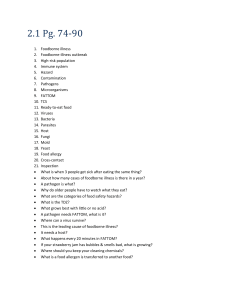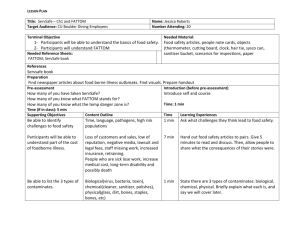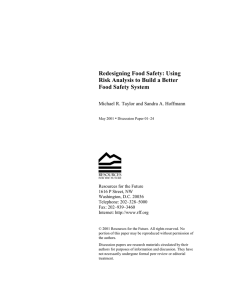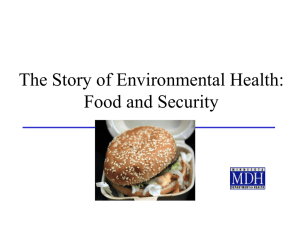Redesigning Food Safety
advertisement
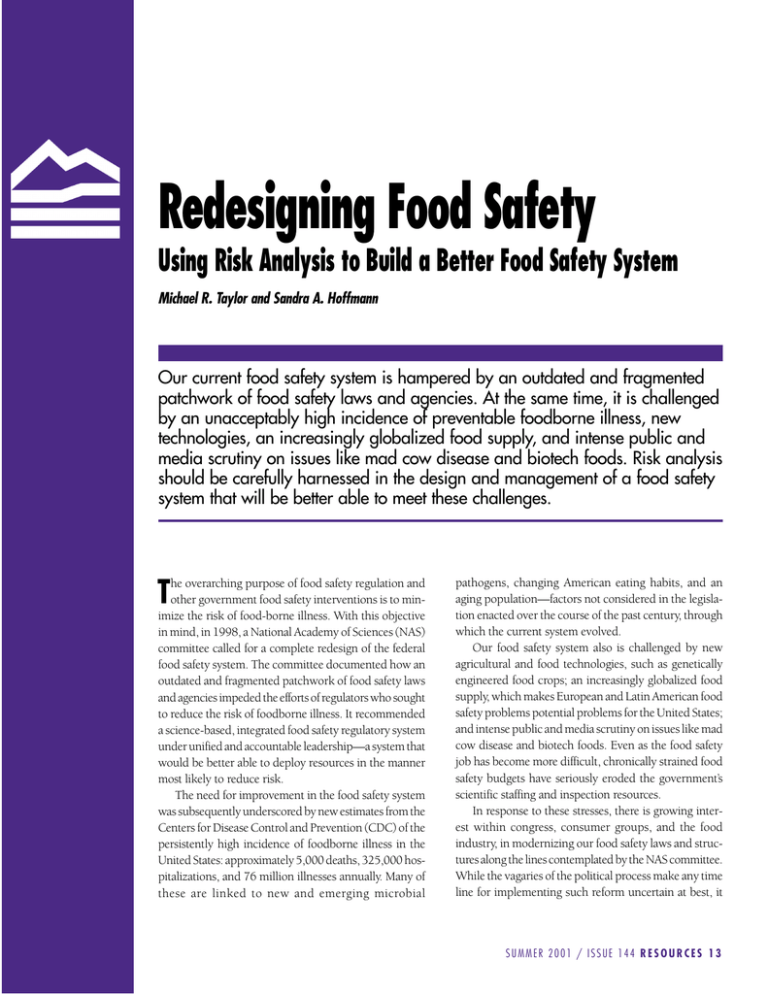
Redesigning Food Safety Using Risk Analysis to Build a Better Food Safety System Michael R. Taylor and Sandra A. Hoffmann Our current food safety system is hampered by an outdated and fragmented patchwork of food safety laws and agencies. At the same time, it is challenged by an unacceptably high incidence of preventable foodborne illness, new technologies, an increasingly globalized food supply, and intense public and media scrutiny on issues like mad cow disease and biotech foods. Risk analysis should be carefully harnessed in the design and management of a food safety system that will be better able to meet these challenges. T he overarching purpose of food safety regulation and other government food safety interventions is to minimize the risk of food-borne illness. With this objective in mind, in 1998, a National Academy of Sciences (NAS) committee called for a complete redesign of the federal food safety system. The committee documented how an outdated and fragmented patchwork of food safety laws and agencies impeded the efforts of regulators who sought to reduce the risk of foodborne illness. It recommended a science-based, integrated food safety regulatory system under unified and accountable leadership—a system that would be better able to deploy resources in the manner most likely to reduce risk. The need for improvement in the food safety system was subsequently underscored by new estimates from the Centers for Disease Control and Prevention (CDC) of the persistently high incidence of foodborne illness in the United States: approximately 5,000 deaths, 325,000 hospitalizations, and 76 million illnesses annually. Many of these are linked to new and emerging microbial pathogens, changing American eating habits, and an aging population—factors not considered in the legislation enacted over the course of the past century, through which the current system evolved. Our food safety system also is challenged by new agricultural and food technologies, such as genetically engineered food crops; an increasingly globalized food supply, which makes European and Latin American food safety problems potential problems for the United States; and intense public and media scrutiny on issues like mad cow disease and biotech foods. Even as the food safety job has become more difficult, chronically strained food safety budgets have seriously eroded the government’s scientific staffing and inspection resources. In response to these stresses, there is growing interest within congress, consumer groups, and the food industry, in modernizing our food safety laws and structures along the lines contemplated by the NAS committee. While the vagaries of the political process make any time line for implementing such reform uncertain at best, it SUMMER 2001 / ISSUE 144 RESOURCES 13 RESOURCES FOR THE FUTURE is not too soon for the scientific and research community to consider what knowledge and methodologies will be needed to design and implement a science-based, integrated system—one capable of prioritizing risk reduction opportunities and deploying resources efficiently. Indeed, better priority setting and more efficient use of available resources are goals that should be pursued regardless of whether Congress modernizes the existing regulatory infrastructure for food safety. Risk analysis will have to play a central role in designing and managing a more science-based, integrated food safety system. Such a system would rely more heavily on biological risk assessments to set food safety standards—with greater emphasis on risks posed by microbial pathogens. Even more important, risk analysis must be harnessed to rank risks and prioritize opportunities for risk reduction so that the government can make the best use of its resources to reduce the risk of foodborne illness. Government’s Role in Food Safety Food safety is, first and foremost, the responsibility of food producers, processors, and others throughout the food chain, including consumers. The government does not produce food and cannot, by itself, make food safe or unsafe. It does, however, play two important roles in the effort to minimize food safety risk. The first and broadest role is to set and enforce food safety standards through laws, regulations, inspections, and compliance actions. This role fulfills the uniquely governmental function of ensuring that those commercially involved in the food system have some accountability to the public for meeting basic food safety standards. The government’s second role is to tackle food safety problems that are beyond the control of any individual participant in the food chain and that require more than a regulatory solution. The dangerous pathogen E. coli O157:H7, for example, originates in the gut of cattle, is spread through the environment to contaminate water and fresh produce, and contaminates beef during the slaughter process, posing a significant hazard when present in any raw or undercooked food. Tackling this and many other food safety problems requires a strong research base; development of effective control measures; and collaboration among growers, animal producers, food processors, retailers, and consumers. Ideally, the government would deploy its resources and focus its efforts across this range of activities in the manner best suited 14 RESOURCES SUMMER 2001 / ISSUE 144 to achieve the primary goal of reducing risk, but the food safety laws do not permit this. Under current law, the Food and Drug Administration (FDA) is authorized to inspect food establishments but is not required to do so. With approximately 50,000 processing and storage facilities under FDA’s jurisdiction and with resources to conduct about 15,000 inspections per year, many plants under FDA’s watch go years without inspection. Even plants FDA rates as “high risk” may be inspected only once a year or less frequently. In contrast, the U.S. Department of Agriculture (USDA) has a statutory mandate to inspect every carcass passing through slaughter establishments and to inspect every meat and poultry processing plant every day, without regard to the relative risks the operations in these plants pose. This bifurcated approach to inspection, which reflects fundamental differences in statutory mandates and modes of regulation between FDA and USDA, skews the allocation of resources in ways that are not optimal for public health and do not maximize the government’s ability to contribute to risk reduction. For example, USDA’s budget for regulating meat and poultry is about $800 million. FDA’s budget for all the rest of the food supply is less than $300 million. USDA employs about 7,600 meat and poultry inspectors, while FDA has a total field staff (inspectors, laboratory technicians, and administrative staff) for all of its food programs of about 1,700.Approximately 3,000 USDA inspectors are committed to the statutorily mandated, carcass-by-carcass inspection program in poultry plants, which NAS evaluated nearly 20 years ago and concluded was unable to address microbial pathogens, the most significant food safety issue affecting poultry. Yet, this inspection program costs $200 million, more than FDA has to inspect the entire food supply beyond meat and poultry. The potential role of risk analysis in improving this situation is apparent. According to the 1998 NAS report, the agencies should be free to allocate their inspection and other resources across the entire food supply to “maximize effectiveness,” which requires “identification of the greatest public health needs through surveillance and risk analysis.” Such an improvement would not only make the core inspection and regulation programs more effective, but it could also improve the government’s efforts to tackle food safety problems through research, collaborative efforts with the food industry, targeted regulatory interventions, and consumer education programs. These efforts are resource intensive, but they can bring about the change in practices and behavior that are often necessary to reduce the RESOURCES FOR THE FUTURE risk of food-borne illness. In recent years, for example, FDA and USDA have carried out initiatives to reduce the risk of illness posed by Salmonella enteriditis in eggs. The result has been a decline in Salmonella enteriditis outbreaks and cases, but only after a significant investment of time and energy. Risk analysis has a critical role to play in deciding which initiatives to pursue and in managing the initiatives. For example, the CDC reports through its FoodNet active surveillance program on cases of illness associated with nine specific bacterial and parasitic pathogens that are significant sources of foodborne illnesses. These pathogens enter the food supply through a range of foods and at different stages of the food production process. If the government is to make the best use of its food safety resources, it should assess and compare the risks posed by various pathogen/food combinations and prioritize opportunities for reducing these risks through targeted research, regulatory, and education initiatives. Likewise, the presence in food of environmental contaminants, such as mercury, lead, and dioxin, remains a matter of public health concern. The government has had success in the past with initiatives to reduce the levels of such contaminants, lead being a notable example. Through risk analysis, the government can identify opportunities for further risk reduction and mount initiatives accordingly. Unfortunately, there are numerous statutory, organizational, and resource constraints on the use of risk analysis in food safety decisionmaking, priority setting, and program design. Central among these are the statutory compartmentalization of the food supply, the antiquated USDA inspection mandate, and the severe underfunding of FDA food safety programs. Together, these features allocate much of the federal food safety resources on the basis of factors other than risk, and impede risk-driven food safety initiatives that consider the food supply as a whole and address risk problems that cut across agency jurisdictional lines. These problems in the food safety system would have to be addressed through legislative action. Improving Risk Analysis to Set Priorities In addition to the need for legislative reform, there is much room for improvement in the data collection and methodologies required to carry out risk analysis of the kind contemplated here. The analyses include risk assessment, risk comparison and ranking (in terms of public health significance), and prioritization of risk reduction opportunities (taking into account feasibility, cost, and social considerations). With regard to risk assessment, CDC reports foodborne illness cases and outbreaks by pathogen, but it does not have complete information about the specific food/pathogen combinations that account for the illness. Because regulatory initiatives and other efforts to reduce risk are necessarily oriented toward specific foods, such information is necessary for risk assessments intended to support regulatory priority setting and resource allocation. Chemical risk assessment also needs attention if it is to contribute as a priority-setting tool. For chronic effects such as carcinogenicity, risk assessment yields quantitative expressions of the estimated upper bound on the risk an individual might be exposed to, based primarily on animal toxicity data. For most other effects, the results of risk assessment for food substances are expressed as an “acceptable daily intake.” In neither case are the results readily comparable to the results of epidemiologically derived estimates of risk associated with microbial pathogens that, typically are expressed in terms of the number of cases of illness associated with a specific pathogen. How can chemical risk assessment and the manner of expressing its results be adapted to foster risk comparison and ranking in relation to microbial hazards? There also is much work to do in the social sciences to meaningfully compare and rank food safety risks for the purpose of better allocating food safety resources. Such comparisons and rankings are inherently complicated due to the diversity of risks and health outcomes of concern and the diversity of values and practical considerations that are relevant to priority setting. Chemical risks range from the acute to the chronic, vary significantly with exposure, sometimes affect age groups differently, and often are predictable only with great uncertainty. Microbiological risks also are diverse—ranging from minor intestinal infections to permanently disabling disease and death—and vary among age groups, while microbial risk assessments are typically grounded in epidemiological data on actual illnesses. How can these factors be taken into account when comparing and ranking the public-health significance of food safety risks? Once risks are ranked for public health significance, further analysis is required to prioritize opportunities for risk reduction. Optimal use of finite government resources should take account of where in the food system opportunities lie to minimize the risk, what are the cost and feasibility of reducing the SUMMER 2001 / ISSUE 144 RESOURCES 15 RESOURCES FOR THE FUTURE risk through government intervention, and how the public perceives and values various risks. To successfully prioritize opportunities for risk reduction, public health experts and social scientists need to collaborate on developing risk analysis methods and prioritization models that consider these and other relevant factors. Conclusion The ultimate objective of risk analysis is not risk comparison and ranking for its own sake or to provide the basis for concluding that some food safety risks are unimportant. In the daily activities of people who produce, market, and consume food, any significant risk of harm is important and should be prevented to the extent reasonably possible. For the government, however, the question is how best to allocate finite resources to reduce the risk of foodborne illness. This requires building on risk comparison and ranking to prioritize opportunities for risk reduction. It means not stopping with an understanding of the relative mag- 16 RESOURCES SUMMER 2001 / ISSUE 144 nitude of food safety risks but examining how the government can make the best use of its resources to reduce risk. The 1998 NAS committee report said, “[T]he cornerstone of a science-based system of food safety is the incorporation of the results of risk analysis into all decisions regarding resource allocation, programmatic priorities, and public education activities.” Achieving this goal will require statutory and organizational reform so that the results of risk analysis can be fully implemented in program design and management. It also will require significantly greater investment to improve the data and methods available for risk analysis. With these changes, the regulatory system can effectively reduce the risk of foodborne illness and, in turn, maintain public confidence in the food supply and preserve America’s international leadership role on food safety. Michael R. Taylor is a senior fellow and the director of RFF’s Center for Risk Management. Sandra A. Hoffmann is a fellow in the Center for Risk Management.
